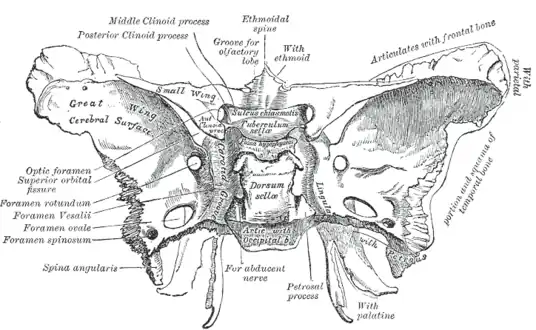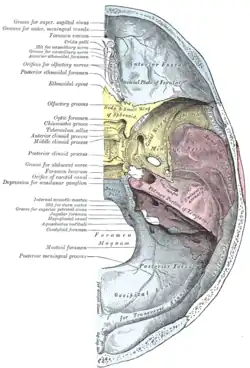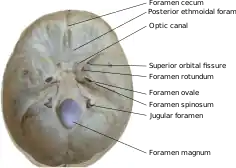Foramen spinosum
| Foramen spinosum | |
|---|---|
 The inner surface of the sphenoid bone, with the foramen spinosum labelled at the left, second from the bottom. | |
 The inner surface of the base of the skull, with the sphenoid bone yellowed. The foramen spinosum is visible at the bottom right of the bone. | |
| Details | |
| Part of | sphenoid bone |
| System | skeletal |
| Identifiers | |
| Latin | Foramen spinosum |
| TA98 | A02.1.05.038 |
| TA2 | 624 |
| FMA | 53156 |
| Anatomical terms of bone | |
The foramen spinosum is a hole located in the greater wing of the sphenoid. It is located posterolateral to the foramen ovale and anterior to the sphenoidal spine. It allows the passage of the middle meningeal artery, middle meningeal vein and usually the meningeal branch of the mandibular nerve (sometimes it passes through the foramen ovale).
The foramen spinosum is often used as a landmark in neurosurgery, due to its close relations with other cranial foramina. It was first described by Jakob Benignus Winslow in the 18th century.
Structure
The foramen spinosum is a foramen in the sphenoid bone of the skull.[1] It connects the middle cranial fossa to the infratemporal fossa. It is located posterolateral to the foramen ovale, and anterior to the sphenoidal spine.
Variation
The foramen spinosum varies in size and location. The foramen is rarely absent, usually unilaterally, in which case the middle meningeal artery enters the cranial cavity through the foramen ovale.[2] It may be incomplete, which may occur in almost half of the population. Conversely, in a minority of cases (less than 1%), it may also be duplicated, particularly when the middle meningeal artery is also duplicated.[2][3]
The foramen may pass through the sphenoid bone at the apex of the spinous process, or along its medial surface.[3]
Development
In the newborn, the foramen spinosum is about 2.25 mm long and in adults about 2.56 mm. The width of the foramen extends from 1.05 mm to about 2.1 mm in adults.[4] The average diameter of the foramen spinosum is 2.63 mm in adults.[5] It is usually between 3 and 4 mm away from the foramen ovale in adults.[6]
The earliest perfect ring-shaped formation of the foramen spinosum was observed in the eighth month after birth and the latest seven years after birth in a developmental study of the foramen rotundum, foramen ovale and foramen spinosum. The majority of the foramina in the skull studies were round in shape.[5] The sphenomandibular ligament, derived from the first pharyngeal arch and usually attached to the spine of the sphenoid bone, may be found attached to the rim of the foramen.[3][7]
Animals
In other great apes, the foramen spinosum is found not in the sphenoid, but in parts of the temporal bone such as the squamous part, found at the sphenosquamosal suture, or absent.[3][8]
Function
The foramen spinosum permits the passage of the middle meningeal artery, middle meningeal vein, and the meningeal branch of the mandibular nerve.[3][9]: 763
Clinical significance
Due to its distinctive position, the foramen is used as an anatomical landmark during neurosurgery. As a landmark, the foramen spinosum reveals the positions of other cranial foramina, the mandibular nerve and trigeminal ganglion, foramen ovale, and foramen rotundum. It may also be relevant in achieving haemostasis during surgery,[3] such as for ligation of the middle meningeal artery.[10] This may be useful in trauma surgery to reduce bleeding into the neurocranium,[3] or for removal of the pyramidal process of the palatine bone.[10]
History
The foramen spinosum was first described by the Danish anatomist Jakob Benignus Winslow in the 18th century. It is so-named because of its relationship to the spinous process of the greater wing of the sphenoid bone. However, due to incorrectly declining the noun, the literal meaning is "hole full of thorns" (Latin: foramen spinosum). The correct, but unused name would, in fact, be foramen spinae.[3]
Additional images
 Inner surface of the base of skull, showing cranial foramina
Inner surface of the base of skull, showing cranial foramina
See also
| Wikimedia Commons has media related to Foramen spinosum. |
References
![]() This article incorporates text in the public domain from page 150 of the 20th edition of Gray's Anatomy (1918)
This article incorporates text in the public domain from page 150 of the 20th edition of Gray's Anatomy (1918)
- ↑ Rea, Paul (2015-01-01). "7 - Essential Anatomy and Function of the Spinal Cord". Essential Clinical Anatomy of the Nervous System. Academic Press. pp. 121–131. doi:10.1016/B978-0-12-802030-2.00007-8. ISBN 978-0-12-802030-2.
{{cite book}}: CS1 maint: date and year (link) - 1 2 "Illustrated Encyclopedia of Human Anatomic Variation: Opus V: Skeletal Systems: Cranium – Sphenoid Bone". Illustrated Encyclopedia of Human Anatomic Variation. Retrieved 2006-04-10.
- 1 2 3 4 5 6 7 8 Krayenbühl, Niklaus; Isolan, Gustavo Rassier; Al-Mefty, Ossama (2 August 2008). "The foramen spinosum: a landmark in middle fossa surgery" (PDF). Neurosurgical Review. 31 (4): 397–402. doi:10.1007/s10143-008-0152-6. PMID 18677523. S2CID 37126697.
- ↑ Lang J, Maier R, Schafhauser O (1984). "Postnatal enlargement of the foramina rotundum, ovale et spinosum and their topographical changes". Anatomischer Anzeiger. 156 (5): 351–87. PMID 6486466.
- 1 2 Yanagi S (1987). "Developmental studies on the foramen rotundum, foramen ovale and foramen spinosum of the human sphenoid bone". The Hokkaido Journal of Medical Science. 62 (3): 485–96. PMID 3610040.
- ↑ Barral, Jean-Pierre; Croibier, Alain (2009-01-01). "9 - Manipulation of the plurineural orifices". Manual Therapy for the Cranial Nerves. Churchill Livingstone. pp. 51–57. doi:10.1016/B978-0-7020-3100-7.50012-4. ISBN 978-0-7020-3100-7.
{{cite book}}: CS1 maint: date and year (link) - ↑ Ort, Bruce Ian Bogart, Victoria (2007). Elsevier's integrated anatomy and embryology. Philadelphia, Pa.: Elsevier Saunders. p. Elsevier’s Integrated Anatomy and Embryology. ISBN 978-1-4160-3165-9.
- ↑ Braga, J.; Crubézy, E.; Elyaqtine, M. (1998). "The posterior border of the sphenoid greater wing and its phylogenetic usefulness in human evolution". American Journal of Physical Anthropology. 107 (4): 387–399. doi:10.1002/(SICI)1096-8644(199812)107:4<387::AID-AJPA2>3.0.CO;2-Y. PMID 9859876.
- ↑ Drake, Richard L.; Vogl, Wayne; Tibbitts, Adam W.M. Mitchell; illustrations by Richard; Richardson, Paul (2005). Gray's anatomy for students. Philadelphia: Elsevier/Churchill Livingstone. ISBN 978-0-8089-2306-0.
- 1 2 Kawase, Takeshi (2010). "38 - Petroclival Meningiomas: Middle Fossa Anterior Transpetrosal Approach". Meningiomas. Saunders. pp. 495–501. doi:10.1016/B978-1-4160-5654-6.00038-6. ISBN 978-1-4160-5654-6.
External links
- Anatomy photo:22:os-0902 at the SUNY Downstate Medical Center – "Osteology of the Skull: Internal Surface of Skull"
- Anatomy figure: 27:02-03 at Human Anatomy Online, SUNY Downstate Medical Center – "Schematic view of key landmarks of the infratemporal fossa."
- Anatomy of the Skull – 27. Foramen spinosum